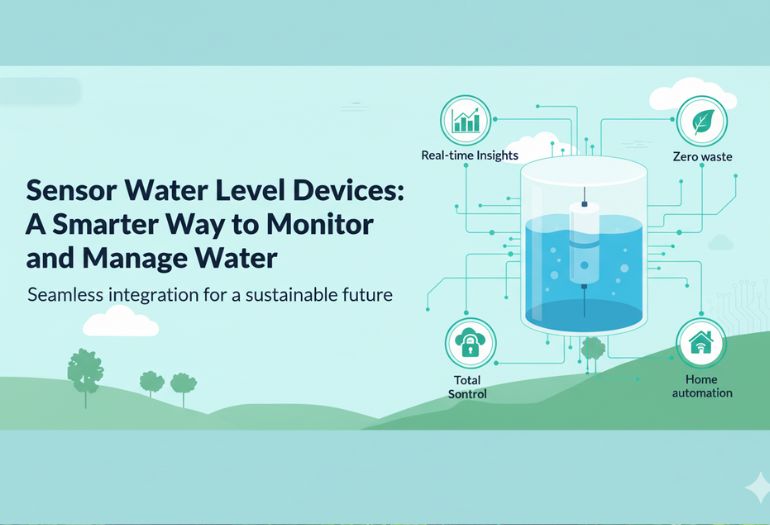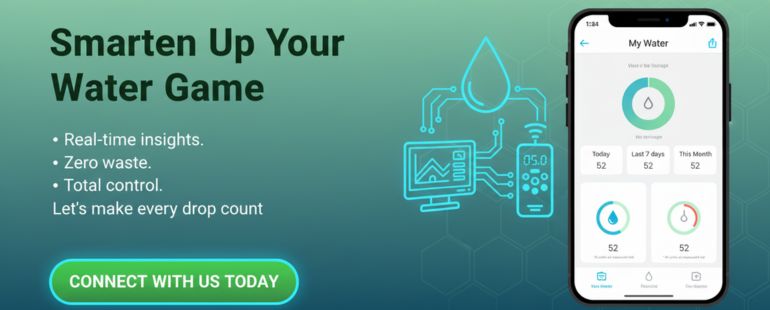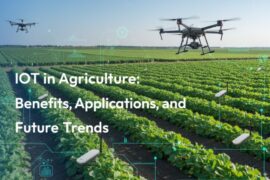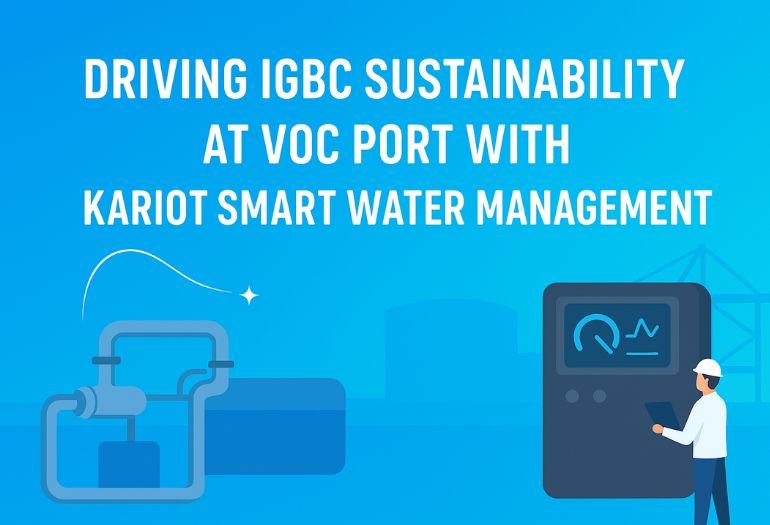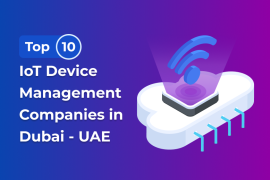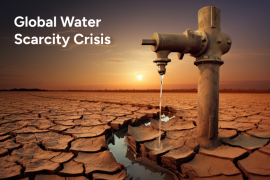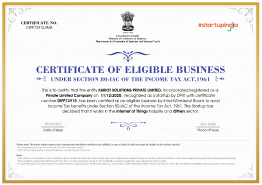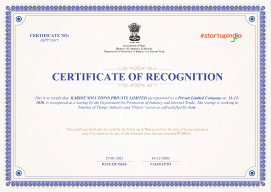Introduction
India’s water infrastructure is facing a crisis. With a rapidly growing population, unpredictable rainfall, and aging distribution networks, managing water resources efficiently has become increasingly challenging. Traditional methods manual tank checks, float switches, and reactive maintenance are slow, prone to errors, and often lead to water loss or supply disruptions. In this context, sensor water level devices provide a smarter, more reliable way to monitor and manage water across homes, farms, industries, and municipalities.
By combining real-time monitoring with technologies such as smart water meters, users gain precise insights into water usage, prevent wastage, and make informed decisions. Whether it’s a rooftop tank in Mumbai or a borewell in rural Tamil Nadu, these devices are redefining how India handles its most precious resource.
What Are Sensor Water Level Devices?
Sensor water level are electronic instruments that measure the amount of water in a container or system. They use technologies like ultrasonic pulses, pressure sensors, or float mechanisms to detect water levels with high accuracy. Also, once installed, they continuously collect data and transmit it to control systems, dashboards, or mobile apps.
Unlike manual methods, these devices offer consistent, automated readings that eliminate guesswork and reduce human error. They can trigger alerts, automate pump operations, and even integrate with broader smart systems. In India, where water supply is often intermittent and unpredictable, these devices help users plan usage, prevent overflow, and avoid dry tanks.
Why Traditional Monitoring Methods Fall Short
Manual iot monitoring has long been the norm in India. Residents climb rooftops to check tank levels, farmers rely on visual cues, and technicians inspect reservoirs with measuring rods. Additionally these methods are not only time-consuming but also unreliable. Float switches can fail due to sediment buildup, and visual inspections often miss subtle changes.
The consequences are serious. For instance, overflowing tanks waste water and energy, while dry tanks damage pumps, and inconsistent supply frustrates users. Fortunately, sensor water level devices solve these problems by offering real-time, automated monitoring that is both reliable and scalable.
How Sensors Improve Accuracy and Efficiency
Precision is critical in iot device management. A few centimeters of miscalculation can lead to overflow, pump burnout, or water shortages. water level devices detect even the smallest changes in water levels and trigger alerts or actions accordingly. For example, a sensor can automatically shut off a pump when the tank is full, or it can send a notification when levels drop below a safe threshold. As a result, this level of control improves operational efficiency, while also reducing maintenance costs and ensuring uninterrupted water supply, especially in high-demand environments like apartment complexes or industrial plants.
Technologies Behind Sensor Water Level Devices
The core technologies powering these devices include:
- Ultrasonic sensors: Emit sound waves and measure the time it takes for them to bounce back from the water surface. Ideal for overhead tanks and open reservoirs.
- Pressure sensors: Detect water depth based on the pressure exerted by the water column. Suitable for underground tanks and borewells.
- Float sensors: Use buoyant mechanisms to trigger switches at specific levels. Common in rural setups due to their simplicity and affordability.
Each technology has its strengths, and choosing the right one depends on the application, environment, and budget.
Urban Applications: Smarter Water Management in Cities
In urban India, water is often stored in rooftop tanks and supplied at scheduled intervals. Managing this supply manually is inefficient and error-prone. Sensor level are now being used in cities like Bengaluru, Pune, and Delhi to automate tank monitoring.
Apartment complexes use these devices to track daily usage, prevent overflow, and optimize pump operations. Municipalities are integrating them into city reservoirs to reduce water loss and improve distribution. These efforts are part of broader initiatives like smart water management using IoT, where connected devices and cloud platforms work together to streamline operations.
Rural Use Cases: Empowering Villages and Farmers
In rural areas, water is stored in borewells, ponds, and community tanks. Monitoring these sources manually is unreliable and labor-intensive. Sensor water level devices help farmers and village administrators track water availability, plan irrigation schedules, and avoid dry spells.
When combined with weather forecasts and soil moisture data, these devices become part of a smart irrigation system using IoT, ensuring that crops receive the right amount of water at the right time. This not only boosts yields but also conserves water a critical resource in drought-prone regions.
Integration with Smart Infrastructure and IoT Platforms
Moreover, sensors don’t operate in isolation. When they are connected to IoT platforms, they become part of a larger smart water ecosystem. Consequently, data collected by sensors is transmitted via gateways to cloud servers, where it is analyzed and visualized for better decision-making.
This integration enables remote monitoring, predictive maintenance, and automated control. For example, a community tank fitted with sensors can send real-time data to a dashboard accessible by municipal staff. This level of connectivity is a hallmark of industrial IoT, which aims to digitize and automate infrastructure across sectors.
Remote Monitoring and Mobile Access
One of the most powerful features of sensor water level devices is remote access. Through mobile apps or web dashboards, users can monitor tank levels, receive alerts, and control pumps from anywhere. This is particularly beneficial in remote villages, disaster-prone areas, as well as large industrial campuses.
Many systems now include an IoT remote monitoring solution, allowing technicians and administrators to manage water systems without being physically present. This reduces travel time, improves response rates, and ensures continuity of service.
Preventing Overflow and Dry Tank Incidents
Overflowing tanks waste water and energy. Dry tanks disrupt supply and damage pumps. Sensor water level devices prevent both by triggering alerts or automated actions when levels cross thresholds.
For instance, a sensor can turn off a pump when the tank is full, or it can send a notification when levels are critically low. Consequently, these features are particularly valuable in high-usage environments, such as factories, hospitals, and housing societies.
Supporting Water Conservation and Sustainability
Water conservation is not just a technical goal it’s a social responsibility. water level devices help users reduce waste, optimize usage, and support sustainability. By providing accurate data and enabling smart control, they encourage responsible water management.
Moreover, this aligns with India’s Jal Jeevan Mission and other national initiatives aimed at ensuring safe and sustainable water for all. Furthermore, when paired with renewable energy sources, such as solar-powered pumps, these devices can further reduce the environmental footprint of water infrastructure.
Challenges in Adoption and How to Overcome Them
Despite their benefits, water level devices face several adoption challenges. For instance, the initial investment can be high, especially for advanced systems. Additionally, many users are unaware of the technology or its benefits. Moreover, poor internet access in rural areas can limit their functionality.
Solutions include government subsidies, awareness campaigns, and hybrid systems that work offline. As technology becomes more affordable and accessible, adoption is expected to grow rapidly.
Customizing Devices for Different Use Cases
No two water systems are alike. A household tank, an industrial reservoir, and a farm pond have different needs.Devices can be customized in terms of sensor type, connectivity, alert settings, and integration.
This flexibility makes them suitable for homes, farms, factories, and municipalities. Whether it’s a basic float sensor for a village tank or an ultrasonic sensor integrated with a cloud dashboard, the technology can be tailored to fit.
Data Visualization and Reporting Features
Modern systems don’t just collect data they present it meaningfully. Dashboards show tank levels, usage trends, and alerts. Reports can be generated for audits, billing, or planning.
These features are part of broader water management platforms that help users make informed decisions. For example, a housing society can track daily consumption and adjust pump schedules accordingly, saving water and energy.
Reducing Maintenance and Operational Costs
Manual monitoring requires labor, time, and frequent repairs. Overflow and pump damage add to costs. Sensor water levels reduce these expenses by automating monitoring and enabling predictive maintenance.
This is especially valuable for industries and municipalities managing large-scale water infrastructure. These benefits are enhanced through IoT device monitoring, which tracks sensor health and performance and flags issues before they escalate.
Government Schemes and Public Utility Integration
Government programs like Jal Jeevan Mission and AMRUT are increasingly incorporating sensor-based technologies. These devices help track supply, detect leaks, and ensure equitable distribution.
By integrating them into public utilities, authorities can reduce non-revenue water and improve service delivery. This aligns with India’s broader push toward digital governance and smart infrastructure.
User-Friendly Interfaces and Mobile Integration
Technology is only useful if it’s accessible. Most sensor water level devices come with user-friendly interfaces, mobile apps, and visual dashboards. These tools make it easy for homeowners, facility managers, and municipal staff to understand and act on the data.
Even in rural areas, basic training can empower users to manage their water systems more effectively. This ease of use is a key factor in driving adoption.
Training and Awareness for Wider Adoption
Many potential users are still unaware of the benefits or assume the technology is too complex or expensive. Outreach programs, pilot projects, and government incentives can help bridge this gap.
As more people experience the benefits firsthand, adoption is likely to accelerate. Training programs for technicians, farmers, and municipal staff can ensure that the technology is used effectively and maintained properly.
Water Loss Comparison in India: Traditional vs IoT Systems
To understand the tangible impact of smart water technologies, it helps to look at the numbers. Across India, traditional water systems suffer from significant inefficiencies leaks, delayed maintenance, and inaccurate monitoring contribute to massive water loss. Sensor water level devices, when integrated with smart platforms, dramatically reduce these losses.
Here’s a comparison of water loss percentages in traditional systems versus IoT-enabled systems across five major regions in India:
| Region | Traditional Systems (%) | Smart IoT Systems (%) |
|---|---|---|
| Delhi NCR | 35 | 12 |
| Maharashtra | 30 | 10 |
| Tamil Nadu | 28 | 9 |
| Karnataka | 32 | 11 |
| West Bengal | 29 | 10 |
Insight: IoT-based systems significantly reduce water loss, saving millions of liters daily in urban India. These improvements are driven by real-time monitoring, automated alerts, and predictive maintenance all made possible by sensor water level devices working in tandem with smart infrastructure.
Future Trends and Innovations
- Artificial Intelligence (AI) enhances smarter decision-making. For example, AI is transforming how sensor water level devices operate. By analyzing consumption patterns, it can forecast demand, detect leaks, and spot unusual usage spikes. As a result, this enables proactive maintenance and better water distribution, which is especially useful in cities with complex water grids or rural areas with seasonal irrigation needs.
- Blockchain for Secure and Transparent Water Data Blockchain technology ensures tamper-proof records of water usage and billing. In municipal systems, it can automate reconciliation between supply and consumption, reduce fraud, and build trust among users. This is especially valuable for public utilities managing large-scale water distribution.
- Edge Computing for Real-Time Responsiveness Edge computing processes data locally at the device level, reducing latency and improving responsiveness. In remote villages or disaster-prone zones with poor connectivity, this ensures that sensor water level devices continue to function and respond instantly even without constant internet access.
- IoT Gateways for Seamless Connectivity These iot gateways act as bridges between sensors and cloud platforms. They collect data from multiple devices and transmit it securely for analysis. In large housing societies or industrial campuses, IoT gateways simplify network management and ensure uninterrupted data flow.
- IoT Device Management for Scalable Operations Managing hundreds of sensors across a city or district requires robust tools. IoT device management platforms allow administrators to configure, update, and troubleshoot devices remotely. This reduces downtime, improves efficiency, and supports large-scale deployment.
- Smart City Integration for Holistic Resource Planning Sensor water level devices are increasingly being integrated into smart city platforms. This means water systems will work alongside energy, transportation, and waste management creating a unified ecosystem. Cities like Pune and Ahmedabad are already exploring such models to improve sustainability and service delivery.
Conclusion
Sensor water level devices are more than just tools they’re enablers of change. They empower individuals, communities, and institutions to take control of their water resources with precision, automation, and insight. In a country where every drop counts, adopting smarter water monitoring isn’t just a technological upgrade it’s a necessity.
As India moves toward smart cities, digital governance, and sustainable development, these devices will play a central role in shaping resilient, efficient, and transparent water systems. From urban apartments to rural farms, from industrial plants to municipal reservoirs, sensor water level devices are paving the way for a future where water is managed wisely, equitably, and sustainably.

